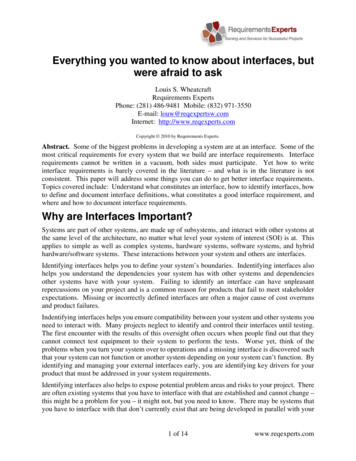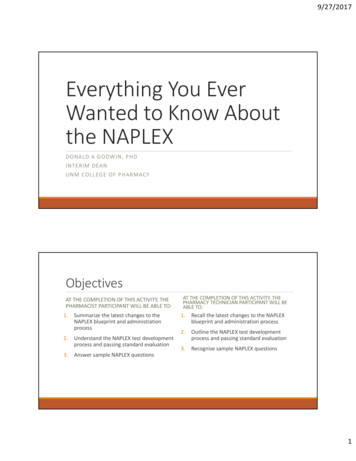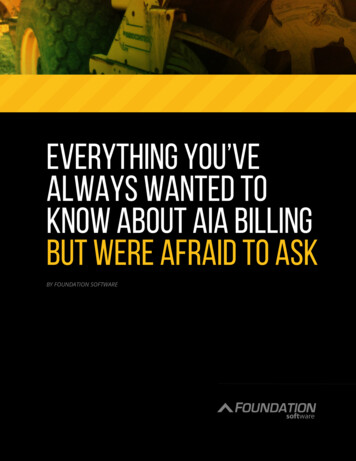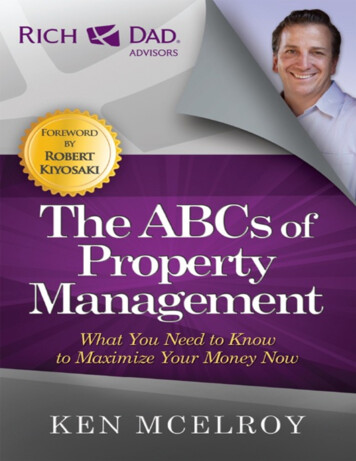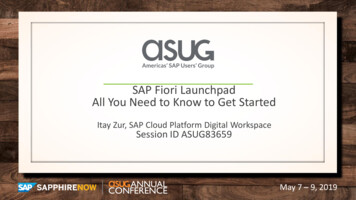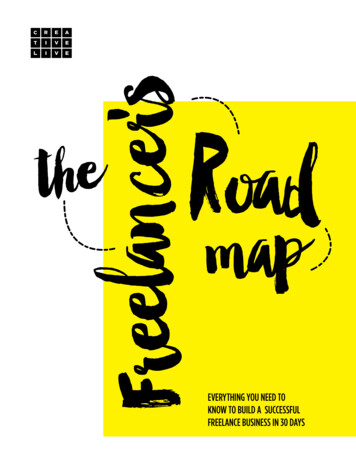
Transcription
EVERYTHING YOU NEED TOKNOW TO BUILD A SUCCESSFULFREELANCE BUSINESS IN 30 DAYS
2INTRODUCTIONThe first time I tried freelancing a few yearsago, it was a massive failure. It was all butimpossible to convince a client to choose mefor the job (any job).Every day, I’d look for new contracts onUpwork and other freelance websites thathad jobs for marketers. I spent a ton of timeresearching each client and putting togethera proposal before reaching out. And still, I hada hell of a time signing even one new clientper month.I couldn’t figure out what was wrong withmy approach, but the lack of steady incomeand mental defeat over the course of severalmonths meant going back to working afull-time job again. That journey led me toCreativeLive.Fast forward a couple of years, and I’m backto freelancing on the side just a few hours perweek. Only now, I’m turning away freelancework and still making significantly more thanI ever was before, while spending much lesstime.The truth is, you can 100% get to where I’m at(and far beyond) in relatively little time. bymaking the right decisions and learning fromthose who’ve already become successful inyour field.I’m Ryan Robinson. I work here at CreativeLivewith our Money & Life instructors, to helpthem grow their influence and build theirbrands.For the creation of this guide, I reached out tosome of the most successful freelancers in theworld, NY Times bestselling business authors,and CreativeLive instructors. I compiled allof their most impactful lessons on how tobecome a highly paid expert and pulled frommy own experience freelancing, to create
3INTRODUCTIONa single guide that’s designed to take youfrom 0 to 1,000 in freelance income.There’s no such thing as a single “trick” orsecret “tactic” that’ll magically guide youdown the path to making millions. Successwon’t happen overnight, but if you’re willingto put in the time and effort it requires tobuild the future you want for yourself, Iguarantee you can make it happen.From building your brand, to pricing yourservices, finding clients, and closing yourfirst major deals, this guide is completewith examples, action steps, and exclusiveCreativeLive content. For the next 4 weeks,you’ll also be getting twice weekly emails withbehind-the-scenes videos, check-in updates,and resources we built for our freelancecommunity.We also created a Facebook Group for ourcommunity of freelancers. We’ll be droppingin frequently with exclusive CreativeLivecontent, challenges, and discussion topicsin the name of building better businessestogether. Be sure to join and introduceyourself!For now, keep reading. Let’s do this.Ryan Robinson
CONTENTSSECTION 1: CREATING A PORTFOLIO AND BUILDING YOUR BRAND15 ESSENTIAL ELEMENTS OF A HIGH QUALITY CREATIVE PORTFOLIOHOW TO BUILD A POWERFUL PERSONAL BRANDSECTION 2: PRICING PSYCHOLOGY & SETTING YOUR RATESHOW TO CALCULATE YOUR FREELANCE HOURLY RATETHE TOP 5 PRICING MISTAKES FREELANCERS MAKESECTION 3: FINDING YOUR FIRST SET OF CLIENTSHOW TO FIND FREELANCE CLIENTS ON FACEBOOK, TWITTER, AND LINKEDINHOW TO GET FREELANCE CLIENTS TO COME TO YOUSECTION 4: PITCHING YOURSELF AND SELLING YOUR SERVICES5 STEPS TO WRITING THE PERFECT FREELANCE PROPOSALTHE ART OF COLD-EMAILING AND WINNING CLIENTSSECTION 5: GROWING BEYOND 1,000 PER MONTH12 FREELANCERS SHARE HOW THEY EARN 100K EACH YEAR
515 ESSENTIAL ELEMENTSOF A HIGH QUALITYCREATIVE PORTFOLIOBY LAURENCE BRADFORDWhat’s the one thing most highly paid freelancers havein common? A powerful personal brand, and the onlineproof (reputation) to back it up.If you’re the best at what you do and you can prove it,you’re in a much better position to set your rates andturn away clients that don’t benefit your business.Sure, you’ll still have to pitch yourself and create greatfreelance proposals, but once you’ve built a powerfulonline presence, it’ll consistently bring you newbusiness. Even if you are a highly skilled freelancer,nobody will know it unless you put in the effortpositioning yourself, building your brand, and havingan impressive online portfolio. In order to effectivelyshowcase your work and expertise in your field, youneed a website that truly sets you apart from thecompetition.Creating a portfolio online can be a major burden forsome people. Talking about yourself, skills, experience,and achievements doesn’t always come naturally. Andon top of that, you have to get all the technologytogether (platform, domain name, online tools, andmuch more).
6But building an online presence is important as afreelancer, because it puts your name on the map andallows you to get discovered by new clients.Luckily, I’ve been through this process already. I havesome tips to help you avoid Strugglefest 2015 whenyou build, or rebuild, your portfolio site.FPOHere are 15 freelance portfolio essentials, that’ll helpyou win higher paying clients for your business.1. Your Specialty.Translation: what you do. However, it’s not just thethings you have the most experience with.Your portfolio is your chance to shape what you’d liketo be known for. even if you’re not known for it *yet*.Whatever it is, get specific about your specialty. Titleslike “digital marketer” or “graphic designer” are vague,but “content marketer” or “logo designer” helps narrowclients down to the ones you really want.This allows you to define your “place” in a big industry.Moreover, this vets potential clients, and may help saveyou time from getting irrelevant propositions for workyou are not interested in or cannot do.2. Examples of Your Work.So, you’ve told people what you do. Now it’s time toshow them.This is an opportunity to curate your work in a way thatshapes your expertise. Choosing to display the rightwork (the work that promotes your specialty) will bringin leads from the right clients.
7While it’s fine to include more low-key projects onyour portfolio, you should make a point to emphasizeyour best work. “Best” may mean a large project, or abig-name client. Basically, put extra emphasis on yourmost impressive projects.More than just examples of previous work, do youFPOhave any other kinds of recognition? Perhaps artexhibits you’ve been in, your photography featuredsomewhere (like in a magazine), an award you won,etc. If yes, include that, too!3. Easy-to-Find Contact Information.Make sure there’s a foolproof way for potential clientsto contact you.This may include your: Email Address Phone Number LinkedIn URL Twitter handleBeyond the contact information, make sure allimportant components of your site are easy to find.Don’t hide your menu items (“About”, “Portfolio”,“Contact”, etc.) or place them in an unusualnavigation bar.4. Your Personality.Others may have your skills. Others may have thesame experience. But no one else has your uniquemixture of hobbies, quirks, and interests. Notincluding these would be a mistake.
8Plus, including your personality makes you morerelatable. “Oh, I love gardening, too!”5. Your Photo.Like with your personality, people want to know whoFPOyou are.and that includes seeing you!When people can put a face to you, they will likeand trust you more. People trust people more than afaceless, impersonal logo. So make sure to include anice, clean-cut photo of yourself on your site.6. About Page or Bio.A great place to showcase your personality andphoto is on your about page. No matter whatindustry you’re in, the about page is one of the mostvisited pages on your site.So put some thought into it! Don’t just throw aphoto up and a quick blurb. Because anyone who isinterested in working with you will almost certainlyread through your About page before reaching out.7. *Relevant* Skills and Education.The keyword here is relevant.You may have a degree in Floral Management, but ifthat doesn’t relate to your current goal of becoming afull-time self-employed logo designer, don’t include iton your portfolio.
9Moreover, don’t list of every skill/tool you everutilized. Showcase the ones you know best, and moreimportantly the ones that are going to help you getthe projects you want.8. A Strong Call to Action (CTA).FPOYour portfolio site should have one main goal. Mostlikely it’s to get a client to hire you.So, you want to make it easy for people to take thataction. (Send you an email for a quote, click yourcontact page, fill out a form, etc.)The most common form of a CTA is a button. Like a“contact me” or a “hire me” or a “find out more”.9. Testimonials.Testimonials, or blurbs about you/your work, addto your legitimacy. They don’t have to be long-formessays, 2-3 sentences can do the trick.Testimonials can come from previous employers orclients. Really, anyone who can speak to your skills.And they don’t necessarily have to come from peoplewho have paid you.Testimonials could also come from: A coworker who can speak to your work ethic/ability Volunteer work Work you did pro-bono when first starting out
10As long as it’s someone who has good things to sayabout your work, you can’t go wrong! (Except you mightwant to avoid including a testimonial from your mom )10. Provide Context.Content and design interplay with each other. SoFPOwrite thought-out descriptions of your work. Alsomake sure to use clear labels as well as language.I prefer when people focus on the key parts of theirwork and break it up into sections.Using different headings, write about: What the assignment was Who the client was What you did The resultsThis makes it more readable than if it was, say, in agigantic paragraph. It also allows a person to skimbetter, and take note of the information they careabout.11. Visually Appealing Site.The images you include on your portfolio (of yourwork and otherwise) can make or break your site.Don’t just slap on some random screenshots of yourwork. Put thought into the pieces you choose toshowcase and how the images of your work interactwith the content around them.
11Here are some tools to help you make your site morevisually appealing: Placeit.net - put your work on different devices Icomoon.io - free vector icons Stock photos that don’t suck Skitch - screenshot toolFPOLook here for a huge list of free website building tools.12. The Right Platform.The “right” platform depends on you. Specifically,your goals, budget, and skill-level.Really short on time and money? Opt for platformslike Behance, Dribbble, LinkedIn, etc. depending onyour industry niche. (It may not be the best option,but using one of these free platforms is better thanhaving no online presence!)Squarespace is a good drag-and-drop option forpeople who can’t code and don’t care about controlover the design. It’s affordable and great for peoplejust getting started.Consider WordPress if you want more control andcustomization, and if you want to have a blog ornews section. (WordPress is really great for bloggers.If blogging will be a key part of your portfolio orfreelance client acquisition strategy, definitelyconsider WordPress.)Of course, you can always make a custom sitewithout the limitations of a platform like Squarespaceor WordPress. This is recommended for people who
12know how to design and develop sites or have thebudget to bankroll a designer/developer.And for a more in-depth list of all the portfoliobuilders available online, check out this article.13. A Professional Domain Name.FPOLet’s face it a .wordpress or .tumblr as part ofyour URL looks unprofessional. Spend the extra tenbucks a year to just get the .com or .org or whateverextension you end up with.Using your name (or some variation of it) is typicallybest. Because while your specialty may change overand over again, your name will not.An exception would be if you’re working on a smallteam; then, consider taking on a business name.Having trouble finding a domain close to your name?Check out domainr.com. It allows you to search aname or word, and it shows you what’s available withdifferent extensions. (Like .me, .co, .io, and so on.)Moreover, tools like Squarespaceand other drag-and-drop platformsmake it easy to add a customdomain name to your site.
1314. Outside opinions.Have a friend or family member give your portfolio alook over for spelling/grammar, but also clarity and easeof use. Because if you confuse people, you lose people.Get feedback and let them tell you how you canFPOimprove your portfolio site.You may think your cousin Joey knows nothing aboutheadshot photography. but your clients might noteither (aside from the fact that they want a newheadshot). In many ways, it’s beneficial to get anopinion from an outsider.You know your website inside and out, so it makes senseto you, but other people may experience it differently.15. Regular Updates.Your portfolio site isn’t permanent. Like you, it shouldevolve. A dead site sends out the message that you’renot getting hired, and maybe that you’ve lost interestin freelancing altogether.So make sure to add recent work samples andupdate other pages on your site regularly. Moreover,maintaining a blog with regular posts is a goodway to show that your site is alive. A blog can alsoposition you as an authority in your field, and cangive you more exposure. And more exposure meansmore potential clients.Ultimately, don’t only look busy; be busy. It’ll makeothers want in on the action, too.
14Conclusion.When it comes down to it, as a freelancer yourportfolio is an asset. And you’ll get what you put intoit. If you want top-notch clients, it’s worth investingthought, time, and even money into doing it right.FPOIf you’re ready to get serious about growing yourfreelance business, check out How to Make Moneyand Grow Your Business with Ramit Sethi.
15THE CREATIVEFREELANCER’S GUIDE TOPERSONAL BRANDINGBY WES MCDOWELLBranding is a fairly misunderstood concept, especiallyfor freelancers.Some oversimplify it, and use it interchangeably withthe idea of logo design. Others blow it way out ofproportion, and think it only has a place with the bigboys in your industry.In truth, branding encompasses nearly every aspectof a company’s personality, including its logo, how itspeaks to its customers, and how it is perceived by thepublic.Branding is not just for the power players. It’s forevery business of any size, including freelancers thatwant to grow their income and create a powerfulreputation for themselves.The Importance of Personal Branding for FreelancersGood branding makes any business memorable.Talented freelancers can benefit from beingremembered, more than most. There are manyskilled designers, photographers and writers who call
16themselves freelancers these days, so you will need tobrand yourself in a unique way, in order to stand outfrom the pack.Whether you’re just getting started on the road tobuilding a freelance career, or you’re a seasonedpro, here are some actionable steps to taking theFPOguesswork out of what makes a memorable personalbrand, and how you can start putting them intopractice today.Your Personality is Your BrandThe first step in the process is defining the uniquepersonality of your brand.This goes for all businesses, but when you’re afreelancer, guess who’s personality you get to use?That’s right, it’s one of those rare occasions whenyour business can be unabashedly all about YOU.After all, you are the brand, so to present a false frontto the world would be unnatural, and ultimately verydifficult to keep going.The 3 Adjective ActivityHere’s my quick process to defining the personalitymy brand’s going to adopt. On a piece of paper, writedown three positive adjectives that: you think describe you. you want your clients to use to describe you.Now it’s gut-check time.
17Just because you think these words describe you,doesn’t mean other people will agree. So, gather afew of your closest friends that you can trust to becompletely honest with you. Ask them to do thesame activity, giving you three descriptive adjectivesbased on the personal brand they feel describes yourfreelance business.FPOAfter that, show them your words, compare, andsee if they agree. If they also used similar wordsto describe your freelance personal brand, thenyou’re already on the right track. If not, it’s time totake a hard look at the forward-facing image you’recurrently giving off, and get feedback on how youcan better align yourself with your three adjectives.These three words will be instrumental in determiningall of your personal branding efforts, so it’s importantto get them right.Your Name vs. Company NameThe next big decision you need to make is yourbusiness name.Many freelancers decide just to use their own namewith their discipline after it, such as “Kyle WalkerPhotography.” Others find it more advantageous touse a separate company name. With a longer termfocus, there are several reasons to go the route ofbranding yourself under a company name:1. If you have a common name.2. If you envision yourself expanding the business intoa team.
18Having a commonly used name can come withcertain drawbacks. Can you get the domain nameyou want for your website? What about social mediaprofiles? If people search for you on Google, are youanywhere near the top of search results? If not, you maywant to go with a “doing-business-as” (DBA) name.FPOSimilarly, if you see yourself growing into a largercompany with staff over time, you might not wantto go with your own name either. In my case, I knewI didn’t want to be a one-man-band forever, so Iditched “Wes McDowell Creative” in favor of the moregrowth-friendly “The Deep End.”If you see yourself growing in the future, it makes waymore sense to start your brand sooner, rather thanlater. Otherwise, once you make the leap, you’ll bestarting all over.If you decide to go with a DBA, keep your threewords in mind, and pick something that reflects them.The Writing FunnelA big part of becoming a highly paid freelancer ishaving an impressive web presence that can sell yourservices round the clock. And because many of yourprospects will be seeing you online long before theyever get a chance to meet you in person, the wordsyou choose will have a big impact on whether youget hired or not.When you consider what has to go into your website,as well as your social media channels, it can seemlike a lot of writing. But, if you write in the right order,
19you can cut your workload down significantly, whilemaintaining a consistent personal brand.Think of it like a funnel. Write the biggest chunksfirst, and distill it down into smaller versions for otherpurposes. Here’s my personal process:FPO1. Start with your full bio. This is what will go on yourwebsite. Start with your three adjectives that describeyour personal brand, and tell a compelling story. Whoare you, and what do you do for your clients that willmake their lives easier, or better?2. Condense it down to a few hundred words or lessfor your Facebook and LinkedIn pages. Keep thetone consistent, but really focus here on what yourclients get from you.3. Shave it down to 140 characters or less forTwitter, and for your most basic elevator pitch.Remember, lead with your most essential corebenefits from a client perspective.4. Narrow it down even further to just a few wordsfor your tagline. This should still strike the right brandmessage, while being super-succinct. No more than afew-word sentence.Keep all of these descriptive personal brandstatements in a single document, in a folder on yourdesktop. In the beginning, you’ll want to refer back tothese descriptions often as a source of inspiration forwriting style and general guidelines as you expandoutward and publish content around the web.
20Your logoNow comes the fun part.Most people get the idea of branding confused withlogo design, but as you can tell by now, creating yourlogo is only one step in the process.FPOAt the expense of sounding like a broken record, youwill need to start with your three adjectives. Your logoshould be a visual interpretation of your personality,so it’s very important at this stage. You want yourprospective clients to be able to get a sense of yourpersonal brand’s core values by taking one look atyour logo.If your branding is playful and quirky, you wouldhave a very different logo than if it were upscale andsophisticated.Keep in mind that there’s no single right answerwhen it comes to choosing how to brand yourself. Aslong as your brand resonates well with your targetcustomers, you’re on the right track.Maybe you’re a freelance designer who can designyour own logo, but if you aren’t that’s fine. Youcan hire one, or even work out a trade with a logodesigner, provided you can give them something theyneed.In the worst case, you can always come up with apurely type-based logo on your own. Many businessesopt for no logo image, and the right typeface canstrike a chord all on it’s own when done right.
21Own Your BrandThe final step in your freelance personal brand is anongoing one. Starting today, you have to be yourbrand. Since your branding is based on what makesyou unique, this should never be a problem.FPOAt the end of the day, you are the one who is incharge of your brand, so protect it. Embody it withevery single client interaction, and keep it consistent.Final ThoughtsAs any creative freelancer knows, working on yourown projects can be the most grueling. But withthe steps we’ve covered here, you should be able toassess your own unique situation, and apply thesebranding principles to make your freelance businessmemorable within your industry.Have you gone through a personal branding activityyourself?Do you have any other advice or stories from theprocess you’d like to share? Leave them in thecomments below so others can benefit from yourexperience!If you’re ready to take your freelance business to thenext level, join Ramit Sethi’s How to Make Money andGrow Your Business for much more.
22
23HOW TO CALCULATE YOURFREELANCE HOURLY RATEBY RYAN ROBINSONNow, here’s a hard question: What is your timereally worth?When you’re a freelancer, it can be really hard totell. As a full-time employee, your salary also takesinto consideration business costs like health care,licensing, taxes, and other business essentials, butwhen you work for yourself, you’ve got to cover all ofthat and more.This is a serious consideration if you’re thinking ofquitting your job in pursuit of leading a more fulfilling,self-employed career. To start, you need to feelconfident when you enter a room and state your price.That way, you have the opportunity to build up yourside income, put away some savings, and bring on afew consistent clients that’ll help you justify makingthe leap to self-employment once you’re ready.Often, in the interest of netting new clients andseeming like a more attractive hire, freelancers willcharge as little as possible, hoping to make up foryour low rates by sheer volume. This kind of pricing,
24which photographer Sue Bryce calls a “survivalrate,” is extremely risky, because it doesn’t take intoaccount the ebb and flow of work, nor does it allowyou to grow your business by expanding markets orinvesting in marketing.When you charge enough to not only survive, butFPOthrive, says Sue, “you find better prospects andclients. It is that simple.”“You find people who can pay what you need toearn then you ask them for it,” she explains.But how do you find out how much is enough toreally grow your business? What’s your thriving rate?We’ve created a handy graphic to help you figure it out.Click to view.Looking for more resources that’ll help you launch asuccessful freelance career?If you’re ready to get serious about growing yourfreelance business, check out How to Make Moneyand Grow Your Business with Ramit Sethi.
25THE TOP 5PRICING MISTAKESFREELANCERS MAKEBY SARAH BRADLEYYou don’t have to be Bob Barker to know when theprice just ain’t right. Products gather dust on shelvesand businesses shutter every day because their basicpricing structure is faulty.To help you avoid the most common pricing mistakes,Tara Gentile — business strategist, creator of theCustomer Perspective Process, and ambassador ofthe You Economy — sat down with us to discussthe pricing errors that freelancers and creativeentrepreneurs typically make.Here are the top five “no-no’s” when pricing yourproduct or service.1. Pricing Too LowPeople often think that low prices equal moresales. However, when you set the price too low, youessentially position your product or service at the“bargain basement” of the market. By doing this,two things happen: you associate your brand andproduct with low quality and you attract the wrongcustomers.
26With the first, customers may assume something iswrong with the company, the product, its credentials— they assume it’s not high-quality. This positionsyour product poorly and leads to less sales.With the second, low prices also put you into theFPOsticky situation of attracting clients who makedecisions based on price rather than quality. Thesetypes of customers tend to be the most demandingcustomers and also the least loyal — always lookingto nickle and dime, rather than really truly get valuefor the service they’re contracting to buy.2. Pricing for Pay, Not ProfitCreative “solopreneur” professionals often don’t allowfor profit in their businesses.When you set prices only with your salary in mind,what you aren’t doing is pricing to invest in yourbusiness and allow for growth activities. Thesegrowth activities — marketing campaigns, hiringadditional help, developing new products, trainingand certification programs — these are the things thatwill get you from a business that is slowly chuggingalong to a business that is thriving.“It’s not just about paying for your labor,” says Tara,“It’s about creating an excess and abundance withthe prices that you set.” Don’t aim for a trickle ofbusiness. Aim for abundance.3. Setting a Narrow Price Spread
27Another mistake that people often make is notlooking at the full spread of their services. When youare offering multiple products or services, customersevaluate a listed price relative to the prices listed forthe rest of the products you are offering — they entera game of “The Price is Right” for this vs that. If youaren’t differentiating your products enough throughFPOprice, you are inhibiting your customer from makingan easy purchase decision.For example, you are a life coach offering threelevels of service: a small ebook, an online course,and one-on-one services. If these things are oftenpriced very similarly ( 20, 30 and 80), it becomesmore difficult for your customers to decide whatthey want to purchase from you, especially if it’s theirfirst purchase and especially if the products all havesimilar outcomes.“Price is one way we help a customer make decision,”says Tara, “People are trained to know that eachtype of thing should cost different amounts relativeto each other, which means you need the spread.”If your products use different materials, requiredifferent amounts of time, or involve varying degreesof effort, you need to use price to differentiate themand make your products and prices make sense interms of the value for your customer.4. Underestimating Labor CostsAnother big mistake people make is assuming theirlabor costs are the same as when they were workinga full-time job. The reason this is an error is thatlabor costs don’t cover a host of expenditures that
28you’ll be making as a business, like administrativeoverhead, the marketing and business developmentcosts of attracting new clients and customers, healthinsurance, etc.“When I was working a retail management job,I thought my labor was valued at 14 an hour,”FPOremembers Tara, “When I started freelancing, 25/hour sounded amazing, but it quickly became clearto me that a living wage for a freelancer is at least 50/hr, and closer to the 75-100/hr range.” That toprange is particularly important if you are looking tocreate some leverage in your business rather than doone-to-one client work.According to Tara, this point should be driven homefor makers and crafters. “Makers are especially bad atthis” she says, “they love to pay themselves less-thanminimum wage.”5. Forgetting Hidden LaborAnother labor-related mistake in setting prices isfailing to account for other people’s labor — both thelabor you are currently contracting or the future laboryou will likely need soon.One way companies grow and gain leverage is byhiring contractors for aspects of the business thatrequire specific skills outside the owner’s expertise.Small businesses often hire outside help for design,marketing, sales, and even contract out for providingthe service or producing the product you sell. Insetting your prices, it’s important to bake theseadditional labor costs into your business expenses
29and account for profit-making on top of them.For more tips and advice on how to price yourservices, check out Value Pricing for CreativeEntrepreneurs with Tara Gentile.FPO
30HOW TO FIND FREELANCECLIENTS ON LINKEDIN,TWITTER, AND FACEBOOKBY LAURENCE BRADFORDWhen it comes to landing clients, relationshipbuilding is a critical component. There’s something tothe “who you know” phrase: thousands of people getjobs through personal connections each year, and thesituation is similar for freelancers trying to find newclients.Here are some pro-tips on how you can relationshipbuild using Facebook, Twitter, and LinkedIn, and usethose connections to get new work.How to find clients on FacebookA key part of finding clients anywhere is networking. Andthe best place to do that on Facebook is within groups.Facebook groups differ from pages in that they canbe secret, private, or public. Unlike pages, a groupis a place where anyone can post. It’s more aboutcommunity and collaboration, whereas pages areusually a company posting their news, events, etc.For freelancers, the key is joining groups whereyour customers are. For instance, if you’re a graphic
31designer, join a group of small business owners/onlineentrepreneurs.who may need graphic design work.Saad Kamal, an a
Upwork and other freelance websites that had jobs for marketers. I spent a ton of time researching each client and putting together a proposal before reaching out. And still, I had a hell of a time signing even one new client per month. I couldn’t figure out what

